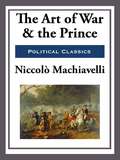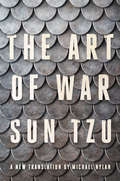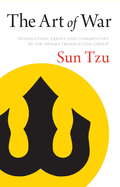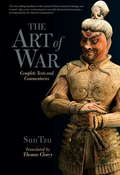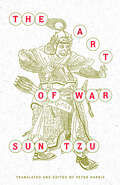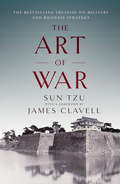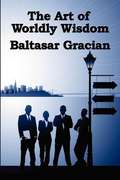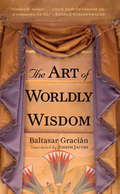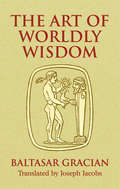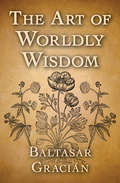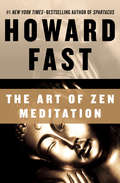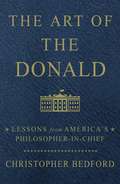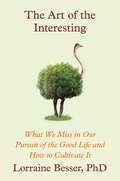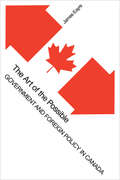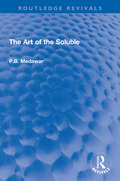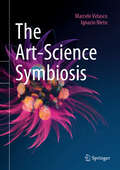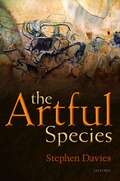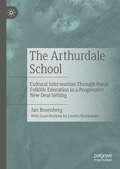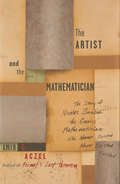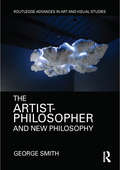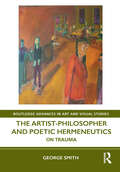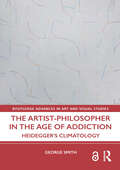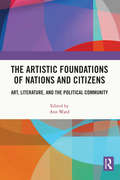- Table View
- List View
The Art of War and Other Chinese Classics
by VariousA compilation of Chinese Classics including The Art of War by Sun Tzu, The Sayings of Lao Tzu translated by Lionel Giles, and I Ching translated by James Legge
The Art of War and the Prince
by Niccolo MachiavelliCollected here in one omnibus edition are Niccolò Machiavelli's most import works, The Art of War and The Prince. It was Niccolò Machiavelli who essentially removed ethics from government. He did it with The Prince, when he asserted that The Prince (president, dictator, prime minister, etc.) does not have to be concerned with ethics, as long as their motivation is to protect the state. It is this questionable belief that in many ways had lead to the modern world as we know it. His assertion was that the head of state must protect the state no matter the cost and no matter what rules he or she breaks in the process. If you want to understand modern politics you must read this book. Machiavelli considered The Art of War his greatest achievement. Here you will learn how to recruit, train, motivate, and discipline an army. You will learn the difference between strategy and tactics. Machiavelli does a masterful job of breaking down and analyzing historic battles. This book of military knowledge belongs alongside Sun-Tzu and Clausewitz on every book shelf.
The Art of War: A New Translation By Michael Nylan
by Sun TzuFor the first time in any modern language, a female scholar and translator reimagines The Art of War. Sun Tzu’s ancient book of strategy and psychology has as much to tell us today as when it was first written 2,500 years ago. In a world forever at odds, his rules for anticipating the motivations and strategies of our competitors never cease to inspire leaders of all kinds. Michael Nylan, in her provocative introduction, sees new and unexpected lessons to be learned from The Art of War—in business ventures, relationships, games of skill, academic careers, and medical practices. Strategy, like conflict, is woven into society’s very roots. Nylan’s crisp translation “offers a masterly new evaluation of this classic work, which balances the overtly military content with a profound and thought-provoking analysis” (Olivia Milburn). Readers newly engaging with ancient Chinese culture will be inspired by Nylan’s authoritative voice. Informed by years of scholarly study, Nylan is uniquely placed to introduce readers to Sun Tzu’s classic work through her detailed annotations on culture and the intricacies of translating ancient Chinese into modern English. She proves that Sun Tzu is more relevant than ever, helping us navigate the conflicts we know and those we have yet to endure.
The Art of War: Complete Text and Commentaries
by Thomas ClearyConflict is an inevitable part of life, according to this ancient Chinese classic of strategy, but everything necessary to respond to conflict wisely, thoroughly, and victoriously is right before us at all times. The key to skillful action in any situation is in knowing those things that make up the environment and then seeing the patterns they form so that their power becomes available to us. It is not necessary to change the nature of things to find victory. Since, as Sun Tzu teaches, aggression and response in kind can lead only to destruction, we must learn to work with conflict in a more profound and effective way. The Art of War shows us how. The Art of War gives us proven strategic skills to apply when we need to take action and overcome obstacles in rapidly changing, chaotic situations. Though ancient in origin, these strategies are accessible because they are based on the ways we already do things. As Sun Tzu shows, rather than getting mired in conflict, we can create momentum and bring about the tipping point to achieve success.
The Art of War: Complete Texts and Commentaries (Shambala Pocket Classics Ser.)
by Sun Tzu Thomas ClearySun Tzu's Art of War, compiled more than two thousand years ago, is a study of the anatomy of organizations in conflict. It is perhaps the most prestigious and influential book of strategy in the world today. Now, this unique volume brings together the essential versions of Sun Tzu's text, along with illuminating commentaries and auxiliary texts written by distinguished strategists. The translations, by the renowned translator Thomas Cleary, have all been published previously in book form, except for The Silver Sparrow Art of War, which is available here for the first time. This collection contains:The Art of War: This edition of Sun Tzu's text includes the classic collection of commentaries by eleven interpreters.Mastering the Art of War: Consisting of essays by two prominent statesmen-generals of Han dynasty China, Zhuge Liang and Liu Ji, this book develops the strategies of Sun Tzu's classic into a complete handbook of organization and leadership. It draws on episodes from Chinese history to show in concrete terms the proper use of Sun Tzu's principles.The Silver Sparrow Art of War: A version of Sun Tzu's Art of War based on a manuscript of the classic text discovered at a Chinese archeological site in China's Shandong Province in 1972, which contains previously unknown fragments.Note: The electronic edition of this book does not contain The Lost Art of War, as seen in the paperback edition.
The Art of War: Large Print (Vintage Classics)
by Sun TzuA new translation of the ancient Chinese military classic that is widely admired by military and business strategists—with an introduction that provides sweeping historical context, and notes featuring contemporary commentary on Sun Tzu's wisdom over the centuries.For more than two thousand years, The Art of War has provided leaders with essential tactical and management advice. An elemental part of Chinese culture, it has also become a touchstone in the West for achieving success, whether on the battlefield or in business. This Vintage Classics edition features a brilliant translation by Peter Harris, first published by Everyman's Library in 2018. Alongside the pithy and powerful ancient text, Harris includes: • Notes • A bibliography • A chronology of Chinese dynasties • A map • Extracts from the canon of classical Chinese commentators • An illuminating introduction on the warrior-philosopher Sun Tzu and the role of The Art of War in history and today
The Art of War: The Bestselling Treatise on Military & Business Strategy, with a Foreword by James Clavell
by James Clavell Sun TzuSun Tzu was one of the greatest army generals who ever lived. He wrote The Art of War in the fifth century BC and yet his words are still resoundingly relevant to our modern lives. His writings on aspects of warfare from the laying of plans to the tactics and psychology of manoeuvering an army, to the proper use of spies, resonate for us in today's world of cut-throat, ruthless business. With James Clavell's insightful foreword and notes, this classic is widely seen as a necessity on the bookshelf of military leaders and boardroom executives alike.
The Art of Worldly Wisdom
by Baltasar GracianIn the Art of Worldly Wisdom Baltasar Gracian gives us pertinent and pithy advice on friendship, leadership, and success. Think of it as Machiavelli with a soul. This book is for those who wish to have an ambitious plan for success without compromising their integrity or losing their way. Audacious and captivating!
The Art of Worldly Wisdom
by Baltasar GracianThis perenially popular book of advice on how to achieve personal and professional success is valued for its timeless insights on how to make one's way in the world. Written in the seventeenth century by a Spanish Jesuit scholar, the teachings are strikingly modern in tone and address universal concerns such as friendship, morality, effective leadership, and how to manage one's emotions. The Art of Worldly Wisdom is for anyone seeking to combine ethical behavior with worldly success.This edition includes an introduction by Willis Barnstone, former Distinguished Professor of Spanish and Comparative Literature at Indiana University. Barnstone, a noted translator, critic, and poet, explores Gracian's background and places him within his historical and literary context. Like Sun Tzu's Art of War, Machiavelli's Prince, and Lao Tzu's Tao Te Ching, Gracian's Art of Worldly Wisdom is one of those rare books that serve as enlightening guides and companions for life.
The Art of Worldly Wisdom
by Joseph Jacobs Baltasar Gracián"Think with the few and speak with the many," "Friends are a second existence," and "Be able to forget" are among this volume's 300 thought-provoking maxims on politics, professional life, and personal development. Published in 1637, it was an instant success throughout Europe. The Jesuit author's timeless advice, focusing on honesty and kindness, remains ever popular. A perfect browsing book of mental and spiritual refreshment, it can be opened at random and appreciated either for a few moments or for an extended period.
The Art of Worldly Wisdom
by Baltasar GraciánLife guidance from a famed Renaissance man. This influential work of philosophy by one of the great thinkers of the Renaissance era advises people of all walks of life how to approach political, professional, and personal situations in a dog-eat-dog world. Comprised of three hundred pithy aphorisms, it offers thought-provoking and accessible advice. Some subjects include &“Never Compete,&” &“The Art of Letting Things Alone,&” and &“Anticipate Injuries and Turn Them into Favours.&” This ebook has been professionally proofread to ensure accuracy and readability on all devices.
The Art of Zen Meditation
by Howard FastBestselling author Howard Fast&’s straightforward introduction to Zen meditationHoward Fast began to formally practice Zen meditation after turning away from communism in 1956. The Art of Zen Meditation, originally published by the antiwar political collective Peace Press in 1977, is the fruit of Fast&’s study: a brief and instructive history of Zen Buddhism and its tenets, written with a simplicity that is emblematic of the philosophy itself. Fast&’s study of Zen also inspired his popular Masao Masuto mystery series about a Zen Buddhist detective in Beverly Hills, which he published under the pseudonym E. V. Cunningham. The Art of Zen Meditation is illustrated with twenty-three beautiful photographs. This ebook features an illustrated biography of Howard Fast including rare photos from the author&’s estate.
The Art of the Donald: Lessons from America's Philosopher-in-Chief
by Christopher BedfordMotivational self-help advice from President Donald Trump, covering everything from leadership and self-confidence to how to succeed in business.President Donald Trump knows about living the good life and achieving success. With his election to the presidency, he added to a life that already includes billions of dollars, worldwide celebrity, and a beautiful family, despite legions of haters. In The Art of the Donald, Daily Caller News Foundation editor-in-chief Christopher Bedford takes you inside the new president’s unorthodox mind, unlocking the genius of his approach to everything in life and offering you insight into navigating life the Trump way. Featuring personal campaign-trail anecdotes and lessons from Trump’s long career as a businessman and politician, The Art of the Donald offers you life-changing pieces of advice, including Keeping your message simple and delivering it effectively; Using competition to govern yourself and chaos to confuse your opponents; Cutting out the middlemen and getting directly to the deal-makers; Redefining conflicts and transactions on your own terms; Solving problems with ingenuity instead of money; and Believing in yourself, no matter what your opponents try to say. Written in the style of Sun Tzu’s The Art of War and The Tao of Warren Buffett, this is a must-read for every Trump fan (and even the haters).
The Art of the Interesting: What We Miss in Our Pursuit of the Good Life and How to Cultivate It
by Lorraine BesserPhilosopher and popular Middlebury professor Dr. Lorraine Besser reveals the missing third piece in our search for the Good Life—what she calls The Interesting—and teaches us how to cultivate it in our lives. Do you know anyone who's truly living The Good Life? Traditionally, philosophers and psychologists have thought of the Good Life in terms of happiness or meaning, or some combination of both. But, if it&’s really that simple, if all you need is more happiness or meaning to get to the Good Life, why aren&’t more of us achieving that truly &“good&” life? You&’ve hit all the traditional markers, jumped on the happiness train, committed to a gratitude practice, sought purpose in your work, and yet The Good Life you&’re seeking, is still out of reach. Emerging research is revealing that there is, in fact, more to the good life than the current —and even ancient—conversation suggests. This has been identified as psychological richness. Dr. Lorraine Besser, a founding investigator in these studies, shows how psychological richness helps to make our Good Lives more interesting. Interesting experiences captivate our minds, engage our thoughts and emotions, and often change our perspective. What&’s interesting is different for everyone, and everyone can obtain and strengthen the skills necessary to access the interesting. In this illuminating book, you&’ll take a deeper dive into the ways that you can cultivate the interesting in your everyday life, including: How to develop an interesting mindset How to harness the power of novelty How to turn obstacles into adventures Through delightful stories, powerful tools, and new mindsets, you&’ll learn how to &“keep it interesting.&” Whether you feel like something is missing from your life, or you&’re yearning for more, Besser's groundbreaking manifesto will guide you toward a fuller, more satisfying life.
The Art of the Possible: Government and Foreign Policy in Canada
by James EayrsThis study, admirable in the logic of its organization and in the freshness of its style, provides an absorbing account of historical developments and current practices in the making of Canada's foreign policy. It analyses carefully and vividly the way in which the prime minister and members of his cabinet, members of the civil service, Parliament, and the military establishment have come together in peace and war to discover "the possible" for Canada's relations with other countries.
The Art of the Soluble (Routledge Revivals)
by P.B. MedawarFirst published in 1967, The Art of the Soluble presents collection of essays giving the views of the author on creativity and originality in science and on the logical connections between creative and critical thought. It is also a pioneering study of the ethology of the scientists – of the anatomy of scientific behaviour. Is it true that scientists are detached or dispassionate observers of Nature? What underlies the scientist’s deep concern over the matters of priority? How did a class distinction grow up between pure and applied science? By what criteria do scientists value their own and their colleagues work? Some of the answers grow out of author’s four critical studies of Teilhard de Chardin, Arthur Koestler, D’Arcy Thompson and Herbert Spencer and the book as whole is knit together by a major essay Hypothesis and Imagination, on the nature of scientific reasoning. P. B. Medawar, who won the Nobel Prize for Medicine in 1960, did not see science as a book-keeping of Nature but, on the contrary, as the greatest of human adventures. This book will be an essential read for scholars and researchers of philosophy of Science, natural science, and philosophy in general
The Art-Science Symbiosis
by Marcelo Velasco Ignacio NietoThis book delves into the long-standing human aspiration to combine art and science. In six chapters, The Art-Science Symbiosis outlines new approaches to understand current scientific practice in general and art-science in particular, showcasing how contemporary art can provide a unique perspective on the meaning and potential of collaboration. With more than a hundred full colour images, The Art-Science Symbiosis serves as a resource for researchers interested in the art-science integration, as well as a general reference for interdisciplinary and transdisciplinary work.In the book, twenty-two works have been selected based on their inherent merits and for the emergent knowledge that their art-science integration produces. These works have sparked novel questions, ideas and curiosity amongst scientists and artists alike which, we hope, will promote further dialogue not only amongst them but with the general public, inspiring a process that may leadto diverse, complex, and promising results with real-world consequences we have as yet to uncover.The Key messages of the book are:● Contemporary art is a powerful space of dialogue between science and the public● Interdisciplinary work based on symmetrical collaboration promotes groundbreaking results● Artistic inquiry can lead to new understanding of scientific exploration● Art-science practice could be started using a simple methodology
The Artful Species: Aesthetics, Art, And Evolution
by Stephen DaviesThe Artful Species explores the idea that our aesthetic responses and art behaviors are connected to our evolved human nature. Our humanoid forerunners displayed aesthetic sensibilities hundreds of thousands of years ago and the art standing of prehistoric cave paintings is virtually uncontested. In Part One, Stephen Davies analyses the key concepts of the aesthetic, art, and evolution, and explores how they might be related. He considers a range of issues, including whether animals have aesthetic tastes and whether art is not only universal but cross-culturally comprehensible. Part Two examines the many aesthetic interests humans take in animals and how these reflect our biological interests, and the idea that our environmental and landscape preferences are rooted in the experiences of our distant ancestors. In considering the controversial subject of human beauty, evolutionary psychologists have traditionally focused on female physical attractiveness in the context of mate selection, but Davies presents a broader view which decouples human beauty from mate choice and explains why it goes more with social performance and self-presentation. Part Three asks if the arts, together or singly, are biological adaptations, incidental byproducts of nonart adaptations, or so removed from biology that they rate as purely cultural technologies. Davies does not conclusively support any one of the many positions considered here, but argues that there are grounds, nevertheless, for seeing art as part of human nature. Art serves as a powerful and complex signal of human fitness, and so cannot be incidental to biology. Indeed, aesthetic responses and art behaviors are the touchstones of our humanity.
The Arthasastra: Selections from the Classic Indian Work on Statecraft
by Patrick Olivelle Mark McclishThe only extant treatise on statecraft from classical India, the Arthsastra is an invaluable resource for understanding ancient South Asian political thought; it also provides a comprehensive and unparalleled panoramic view of Indian society during the period between the Maurya (320-185 BCE) and Gupta (320-497 CE) empires.This volume offers modern English translations of key selections, organized thematically, from the Arthasastra. A general Introduction briefly traces the arc of ancient South Asian history, explains the classical Indian tradition of statecraft, and discusses the origins and importance of the Arthasastra. Thorough explanatory essays and notes set each excerpt in its intellectual, political, and cultural contexts.
The Arthurdale School: Cultural Intervention Through Rural Folklife Education in a Progressive New Deal Setting
by Jan RosenbergThis book chronicles the school envisioned by Eleanor Roosevelt in 1933 to serve Arthurdale, the New Deal government-created community in north-central West Virginia. Arthurdale was founded to house unemployed miners and their families and provide them with opportunities to receive healthcare and obtain gainful employment. Roosevelt had a particular interest in the education of children, feeling that education and social life were profoundly intertwined within a community. With that in mind, in 1934, she hired Elsie Ripley Clapp—an educator and leader in the Progressive Education movement—to design and implement the school, as well as oversee the social life of Arthurdale as a whole. In addition to covering the Arthurdale School's birth, life, and dissolution, Rosenberg discusses how the lessons of the school might serve the culture of education today, especially as an element of a comprehensive approach to community revitalization.
The Artist and the Mathematician
by Amir AczelNicolas Bourbaki, whose mathematical publications began to appear in the late 1930s and continued to be published through most of the twentieth century, was a direct product as well as a major force behind an important revolution that took place in the early decades of the twentieth century that completely changed Western culture. Pure mathematics, the area of Bourbaki's work, seems on the surface to be an abstract field of human study with no direct connection with the real world. In reality, however, it is closely intertwined with the general culture that surrounds it. Major developments in mathematics have often followed important trends in popular culture; developments in mathematics have acted as harbingers of change in the surrounding human culture. The seeds of change, the beginnings of the revolution that swept the Western world in the early decades of the twentieth century -- both in mathematics and in other areas -- were sown late in the previous century. This is the story both of Bourbaki and the world that created him in that time. It is the story of an elaborate intellectual joke -- because Bourbaki, one of the foremost mathematicians of his day -- never existed.
The Artist-Philosopher and New Philosophy (Routledge Advances in Art and Visual Studies)
by George SmithIn The Artist-Philosopher and New Philosophy, Smith argues that Western Metaphysics has indeed come to what Heidegger describes as “an end.” That is hardly to say philosophy as such is over or soon to disappear; rather, its purpose as a medium of cultural change and as a generator of history has run its course. He thus calls for a New Philosophy, conceptualized by the artist-philosopher who “makes” or “poeticizes” New Philosophy, spanning literary and theoretical discourses and operating across art in all its forms and across culture in all its locations. To this end, Smith proposes the establishment of schools and social networks that advance the training and development of artist-philosophers, as well as global digital networks that are themselves designed toward this “ever-becoming community.”
The Artist-Philosopher and Poetic Hermeneutics: On Trauma (Routledge Advances in Art and Visual Studies)
by George SmithFocusing on the aesthetic representation of trauma, George Smith outlines the nexus points between poetics and hermeneutics and shows how a particular kind of thinker, the artist-philosopher, practices interpretation in an entirely different way from traditional hermeneutics. Taking a transhistorical and global view, Smith engages artists, writers, and thinkers from Western and non-Western periods, regions, and cultures. Thus, we see that poetic hermeneutics reconstitutes philosophy and art as hybridizations of art and science, the artist and the philosopher, subject and object. In turn, the artist-philosopher's poetic-hermeneutic reconstitution of philosophy and art is meant to transform human consciousness. This book will be of interest to artists and scholars working in studio practice, art history, aesthetics, philosophy, cultural studies, history of ideas, history of consciousness, psychoanalytic studies, myth studies, literary studies, and creative writing.
The Artist-Philosopher in the Age of Addiction: Heidegger’s Climatology (Routledge Advances in Art and Visual Studies)
by George SmithGeorge Smith argues that modern humanity suffers from a late-stage, pre-fatal addiction to scientific-technological thinking. Like most pre-fatal addictions, this one will most likely result in one of three ways: misery, extinction, or human transformation. The question remains, wherein lies the third way?According to Smith, mankind’s chronic and as yet undiagnosed sickness originates in early Western metaphysics and has long been thoroughly globalized. It explains unstoppable extractionism and its relentlessly increasing by-product, carbon dioxide. It also explains today’s ever-increasing rate of species extinction and the increasingly likely collapse of the biosphere. Citing climate change tolerance and denial as symptomatic of pre-fatal addiction, Smith turns his analysis to Heidegger’s "question concerning technology" and shows that even Heidegger had become "hooked" on scientific-technological thinking. Surrendering to his disease, Heidegger "steps back" into "meditative thought." This in turn opens Heidegger to an East-West mode of scientific-poetic consciousness, the thinking of artist-philosophers such as Laozi, Hölderlin, and Rachel Carson. For Heidegger, this way of thinking lays the path to mankind’s transformative emancipation from an otherwise inescapable catastrophe.The book will be of interest to scholars of the arts and culture, histories of consciousness, and climate studies.
The Artistic Foundations of Nations and Citizens: Art, Literature, and the Political Community
by Ann WardThis book examines politics through the lens of art and literature. Through discussion on great works of visual art, literature, and cultural representations of political thought in the medieval, early modern, and American eras, it explores the relevance of the nation-state to human freedom and flourishing, as well as the concept of citizenship and statesmanship that it implies, in contrast to that of the ‘global community’. The essays in this volume focus on shifting notions of various core political concepts like citizenship, republicanism, and nationalism from antiquity to the present-day to provide a systematic understanding of their evolving histories through Western Art and literature. It highlights works such as the Bayeux Tapestry, Shakespeare’s Henry V, Henry VI, and A Midsummer Night’s Dream, Twain’s Joan of Arc and Hermann’s Nichts als Gespenster, among several other canonical works of political interest. Further, it questions if we should now look beyond the nation-state to some form of tans-national, global community to pursue the human freedom desired by progressives, or look at smaller forms of community resembling the polis to pursue the friendship and nobility valued by the ancients. The volume will be invaluable to students and teachers of political science, especially political theory and philosophy, visual arts, and world literature.

